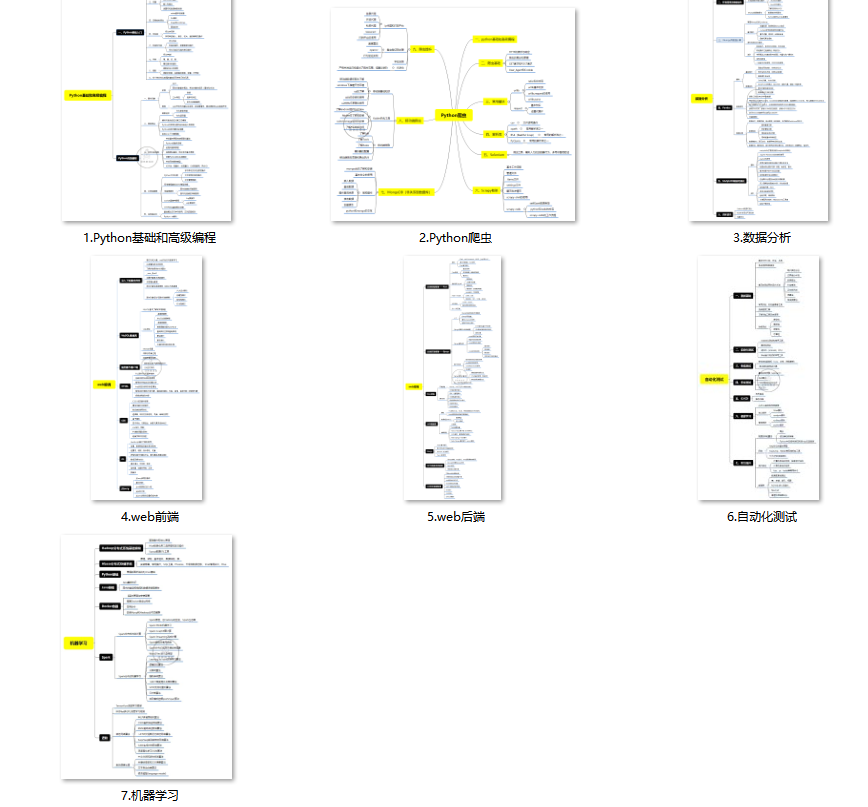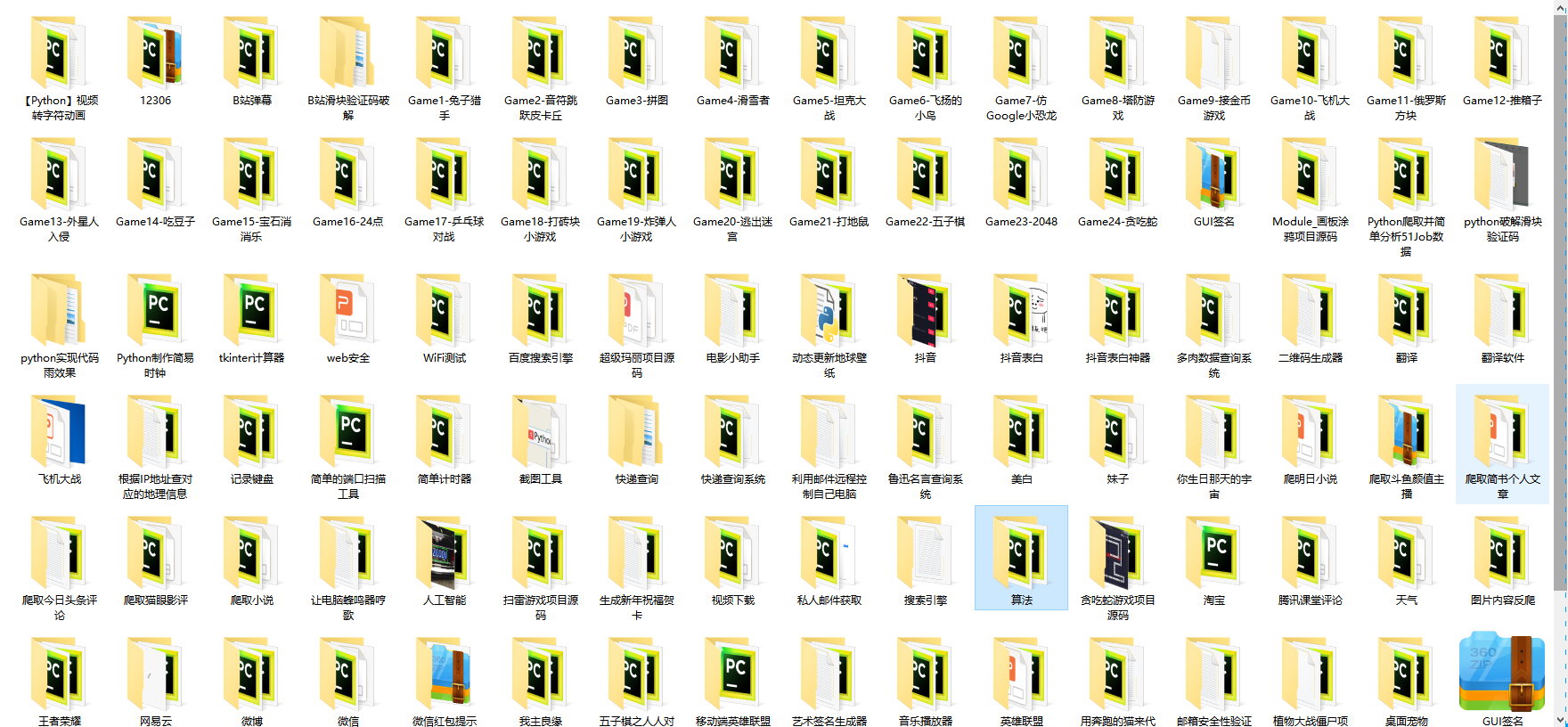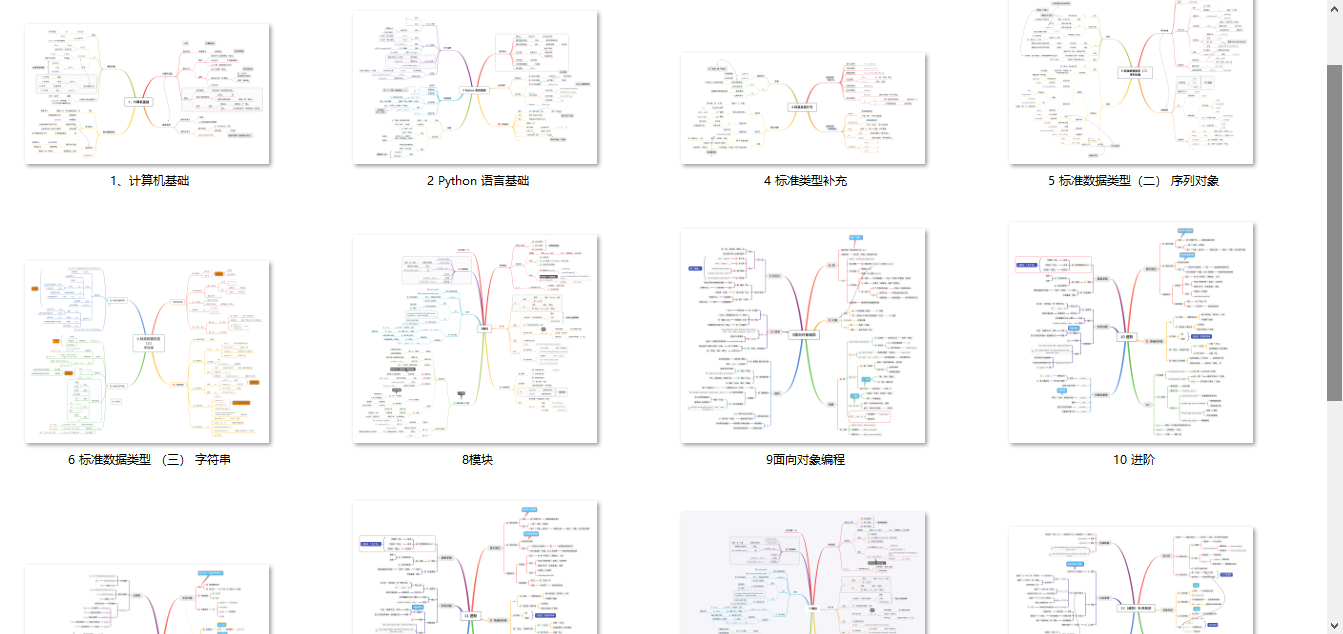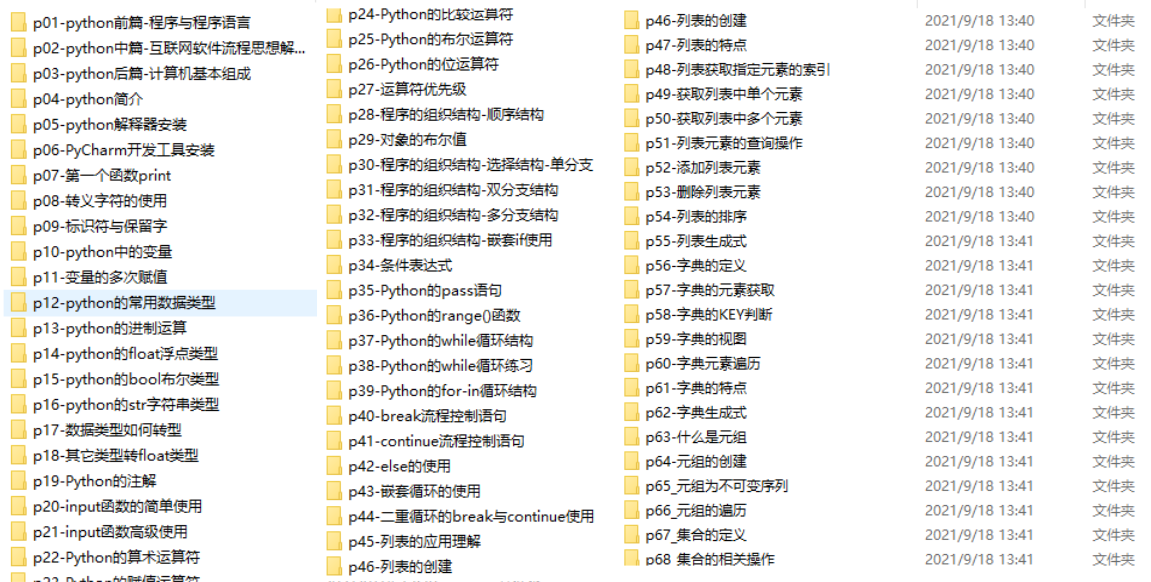做了那么多年开发,自学了很多门编程语言,我很明白学习资源对于学一门新语言的重要性,这些年也收藏了不少的Python干货,对我来说这些东西确实已经用不到了,但对于准备自学Python的人来说,或许它就是一个宝藏,可以给你省去很多的时间和精力。
别在网上瞎学了,我最近也做了一些资源的更新,只要你是我的粉丝,这期福利你都可拿走。
我先来介绍一下这些东西怎么用,文末抱走。
(1)Python所有方向的学习路线(新版)
这是我花了几天的时间去把Python所有方向的技术点做的整理,形成各个领域的知识点汇总,它的用处就在于,你可以按照上面的知识点去找对应的学习资源,保证自己学得较为全面。
最近我才对这些路线做了一下新的更新,知识体系更全面了。

(2)Python学习视频
包含了Python入门、爬虫、数据分析和web开发的学习视频,总共100多个,虽然没有那么全面,但是对于入门来说是没问题的,学完这些之后,你可以按照我上面的学习路线去网上找其他的知识资源进行进阶。

(3)100多个练手项目
我们在看视频学习的时候,不能光动眼动脑不动手,比较科学的学习方法是在理解之后运用它们,这时候练手项目就很适合了,只是里面的项目比较多,水平也是参差不齐,大家可以挑自己能做的项目去练练。

(4)200多本电子书
这些年我也收藏了很多电子书,大概200多本,有时候带实体书不方便的话,我就会去打开电子书看看,书籍可不一定比视频教程差,尤其是权威的技术书籍。
基本上主流的和经典的都有,这里我就不放图了,版权问题,个人看看是没有问题的。
(5)Python知识点汇总
知识点汇总有点像学习路线,但与学习路线不同的点就在于,知识点汇总更为细致,里面包含了对具体知识点的简单说明,而我们的学习路线则更为抽象和简单,只是为了方便大家只是某个领域你应该学习哪些技术栈。

(6)其他资料
还有其他的一些东西,比如说我自己出的Python入门图文类教程,没有电脑的时候用手机也可以学习知识,学会了理论之后再去敲代码实践验证,还有Python中文版的库资料、MySQL和HTML标签大全等等,这些都是可以送给粉丝们的东西。

这些都不是什么非常值钱的东西,但对于没有资源或者资源不是很好的学习者来说确实很不错,你要是用得到的话都可以直接抱走,关注过我的人都知道,这些都是可以拿到的。
网上学习资料一大堆,但如果学到的知识不成体系,遇到问题时只是浅尝辄止,不再深入研究,那么很难做到真正的技术提升。
一个人可以走的很快,但一群人才能走的更远!不论你是正从事IT行业的老鸟或是对IT行业感兴趣的新人,都欢迎加入我们的的圈子(技术交流、学习资源、职场吐槽、大厂内推、面试辅导),让我们一起学习成长!
4.将源目录240天以上的所有文件移动到目标目录。
import shutil
import sys
import time
import os
import argparse
usage = ‘python move_files_over_x_days.py -src [SRC] -dst [DST] -days [DAYS]’
description = ‘Move files from src to dst if they are older than a certain number of days. Default is 240 days’
args_parser = argparse.ArgumentParser(usage=usage, description=description)
args_parser.add_argument(‘-src’, ‘–src’, type=str, nargs=‘?’, default=‘.’, help=‘(OPTIONAL) Directory where files will be moved from. Defaults to current directory’)
args_parser.add_argument(‘-dst’, ‘–dst’, type=str, nargs=‘?’, required=True, help=‘(REQUIRED) Directory where files will be moved to.’)
args_parser.add_argument(‘-days’, ‘–days’, type=int, nargs=‘?’, default=240, help=‘(OPTIONAL) Days value specifies the minimum age of files to be moved. Default is 240.’)
args = args_parser.parse_args()
if args.days < 0:
args.days = 0
src = args.src # 设置源目录
dst = args.dst # 设置目标目录
days = args.days # 设置天数
now = time.time() # 获得当前时间
if not os.path.exists(dst):
os.mkdir(dst)
for f in os.listdir(src): # 遍历源目录所有文件
if os.stat(f).st_mtime < now - days * 86400: # 判断是否超过240天
if os.path.isfile(f): # 检查是否是文件
shutil.move(f, dst) # 移动文件
5.扫描脚本目录,并给出不同类型脚本的计数。
import os
import shutil
from time import strftime
logsdir=“c:\logs\puttylogs”
zipdir=“c:\logs\puttylogs\zipped_logs”
zip_program=“zip.exe”
for files in os.listdir(logsdir):
if files.endswith(“.log”):
files1=files+“.”+strftime(“%Y-%m-%d”)+“.zip”
os.chdir(logsdir)
os.system(zip_program + " " + files1 +" "+ files)
shutil.move(files1, zipdir)
os.remove(files)
6.下载Leetcode的算法题。
‘’’
遇到问题没人解答?小编创建了一个Python学习交流QQ群:579817333
寻找有志同道合的小伙伴,互帮互助,群里还有不错的视频学习教程和PDF电子书!
‘’’
import sys
import re
import os
import argparse
import requests
from lxml import html as lxml_html
try:
import html
except ImportError:
import HTMLParser
html = HTMLParser.HTMLParser()
try:
import cPickle as pk
except ImportError:
import pickle as pk
class LeetcodeProblems(object):
def get_problems_info(self):
leetcode_url = ‘https://leetcode.com/problemset/algorithms’
res = requests.get(leetcode_url)
if not res.ok:
print(‘request error’)
sys.exit()
cm = res.text
cmt = cm.split(‘tbody>’)[-2]
indexs = re.findall(r’(\d+)', cmt)
problem_urls = [‘https://leetcode.com’ + url \
for url in re.findall(
r’<a href=“(/problems/.+?)”', cmt)]
levels = re.findall(r"(.+?)", cmt)
tinfos = zip(indexs, levels, problem_urls)
assert (len(indexs) == len(problem_urls) == len(levels))
infos = []
for info in tinfos:
res = requests.get(info[-1])
if not res.ok:
print(‘request error’)
sys.exit()
tree = lxml_html.fromstring(res.text)
title = tree.xpath(‘//meta[@property=“og:title”]/@content’)[0]
description = tree.xpath(‘//meta[@property=“description”]/@content’)
if not description:
description = tree.xpath(‘//meta[@property=“og:description”]/@content’)[0]
else:
description = description[0]
description = html.unescape(description.strip())
tags = tree.xpath(‘//div[@id=“tags”]/following::a[@class=“btn btn-xs btn-primary”]/text()’)
infos.append(
{
‘title’: title,
‘level’: info[1],
‘index’: int(info[0]),
‘description’: description,
‘tags’: tags
}
)
with open(‘leecode_problems.pk’, ‘wb’) as g:
pk.dump(infos, g)
return infos
def to_text(self, pm_infos):
if self.args.index:
key = ‘index’
elif self.args.title:
key = ‘title’
elif self.args.tag:
key = ‘tags’
elif self.args.level:
key = ‘level’
else:
key = ‘index’
infos = sorted(pm_infos, key=lambda i: i[key])
text_template = ‘## {index} - {title}\n’ \
‘{level} {tags}\n’ \
‘{description}\n’ + ‘\n’ * self.args.line
text = ‘’
for info in infos:
if self.args.rm_blank:
info[‘description’] = re.sub(r’[\n\r]+‘, r’\n’, info[‘description’])
text += text_template.format(**info)
with open(‘leecode problems.txt’, ‘w’) as g:
g.write(text)
def run(self):
if os.path.exists(‘leecode_problems.pk’) and not self.args.redownload:
with open(‘leecode_problems.pk’, ‘rb’) as f:
pm_infos = pk.load(f)
else:
pm_infos = self.get_problems_info()
print(‘find %s problems.’ % len(pm_infos))
self.to_text(pm_infos)
def handle_args(argv):
p = argparse.ArgumentParser(description=‘extract all leecode problems to location’)
p.add_argument(‘–index’, action=‘store_true’, help=‘sort by index’)
p.add_argument(‘–level’, action=‘store_true’, help=‘sort by level’)
p.add_argument(‘–tag’, action=‘store_true’, help=‘sort by tag’)
p.add_argument(‘–title’, action=‘store_true’, help=‘sort by title’)
p.add_argument(‘–rm_blank’, action=‘store_true’, help=‘remove blank’)
p.add_argument(‘–line’, action=‘store’, type=int, default=10, help=‘blank of two problems’)
p.add_argument(‘-r’, ‘–redownload’, action=‘store_true’, help=‘redownload data’)
args = p.parse_args(argv[1:])
return args
def main(argv):
args = handle_args(argv)
x = LeetcodeProblems()
x.args = args
x.run()
if name == ‘main’:
argv = sys.argv
main(argv)
7.将 Markdown 转换为 HTML。
import sys
import os
from bs4 import BeautifulSoup
import markdown
class MarkdownToHtml:
headTag = ‘’
def init(self,cssFilePath = None):
if cssFilePath != None:
self.genStyle(cssFilePath)
def genStyle(self,cssFilePath):
with open(cssFilePath,‘r’) as f:
cssString = f.read()
self.headTag = self.headTag[:-7] + ‘’.format(cssString) + self.headTag[-7:]
def markdownToHtml(self, sourceFilePath, destinationDirectory = None, outputFileName = None):
if not destinationDirectory:
未定义输出目录则将源文件目录(注意要转换为绝对路径)作为输出目录
destinationDirectory = os.path.dirname(os.path.abspath(sourceFilePath))
if not outputFileName:
未定义输出文件名则沿用输入文件名
outputFileName = os.path.splitext(os.path.basename(sourceFilePath))[0] + ‘.html’
if destinationDirectory[-1] != ‘/’:
destinationDirectory += ‘/’
with open(sourceFilePath,‘r’, encoding=‘utf8’) as f:
markdownText = f.read()
编译出原始 HTML 文本
rawHtml = self.headTag + markdown.markdown(markdownText,output_format=‘html5’)
格式化 HTML 文本为可读性更强的格式
beautifyHtml = BeautifulSoup(rawHtml,‘html5lib’).prettify()
with open(destinationDirectory + outputFileName, ‘w’, encoding=‘utf8’) as f:
f.write(beautifyHtml)
if name == “main”:
mth = MarkdownToHtml()
做一个命令行参数列表的浅拷贝,不包含脚本文件名
argv = sys.argv[1:]
目前列表 argv 可能包含源文件路径之外的元素(即选项信息)
程序最后遍历列表 argv 进行编译 markdown 时,列表中的元素必须全部是源文件路径
outputDirectory = None
if ‘-s’ in argv:
cssArgIndex = argv.index(‘-s’) +1
cssFilePath = argv[cssArgIndex]
检测样式表文件路径是否有效
if not os.path.isfile(cssFilePath):
print('Invalid Path: '+cssFilePath)
sys.exit()
mth.genStyle(cssFilePath)
pop 顺序不能随意变化
argv.pop(cssArgIndex)
argv.pop(cssArgIndex-1)
if ‘-o’ in argv:
dirArgIndex = argv.index(‘-o’) +1
outputDirectory = argv[dirArgIndex]
检测输出目录是否有效
if not os.path.isdir(outputDirectory):
print('Invalid Directory: ’ + outputDirectory)
sys.exit()
pop 顺序不能随意变化
argv.pop(dirArgIndex)
argv.pop(dirArgIndex-1)
至此,列表 argv 中的元素均是源文件路径
遍历所有源文件路径
for filePath in argv:
判断文件路径是否有效
if os.path.isfile(filePath):
mth.markdownToHtml(filePath, outputDirectory)
else:
print('Invalid Path: ’ + filePath)
8.文本文件编码检测与转换。
import sys
import os
import argparse
from chardet.universaldetector import UniversalDetector
parser = argparse.ArgumentParser(description = ‘文本文件编码检测与转换’)
parser.add_argument(‘filePaths’, nargs = ‘+’,
help = ‘检测或转换的文件路径’)
parser.add_argument(‘-e’, ‘–encoding’, nargs = ‘?’, const = ‘UTF-8’,
help = ‘’’
目标编码。支持的编码有:
ASCII, (Default) UTF-8 (with or without a BOM), UTF-16 (with a BOM),
UTF-32 (with a BOM), Big5, GB2312/GB18030, EUC-TW, HZ-GB-2312, ISO-2022-CN, EUC-JP, SHIFT_JIS, ISO-2022-JP,
ISO-2022-KR, KOI8-R, MacCyrillic, IBM855, IBM866, ISO-8859-5, windows-1251, ISO-8859-2, windows-1250, EUC-KR,
ISO-8859-5, windows-1251, ISO-8859-1, windows-1252, ISO-8859-7, windows-1253, ISO-8859-8, windows-1255, TIS-620
‘’')
parser.add_argument(‘-o’, ‘–output’,
help = ‘输出目录’)
解析参数,得到一个 Namespace 对象
args = parser.parse_args()
输出目录不为空即视为开启转换, 若未指定转换编码,则默认为 UTF-8
if args.output != None:
if not args.encoding:
默认使用编码 UTF-8
args.encoding = ‘UTF-8’
检测用户提供的输出目录是否有效
if not os.path.isdir(args.output):
print('Invalid Directory: ’ + args.output)
sys.exit()
else:
if args.output[-1] != ‘/’:
args.output += ‘/’
实例化一个通用检测器
detector = UniversalDetector()
print()
print(‘Encoding (Confidence)’,‘:’,‘File path’)
for filePath in args.filePaths:
检测文件路径是否有效,无效则跳过
if not os.path.isfile(filePath):
print('Invalid Path: ’ + filePath)
continue
重置检测器
detector.reset()
以二进制模式读取文件
for each in open(filePath, ‘rb’):
检测器读取数据
detector.feed(each)
若检测完成则跳出循环
if detector.done:
break
关闭检测器
detector.close()
读取结果
charEncoding = detector.result[‘encoding’]
confidence = detector.result[‘confidence’]
打印信息
if charEncoding is None:
charEncoding = ‘Unknown’
confidence = 0.99
print(‘{} {:>12} : {}’.format(charEncoding.rjust(8),
‘(’+str(confidence*100)+‘%)’, filePath))
if args.encoding and charEncoding != ‘Unknown’ and confidence > 0.6:
若未设置输出目录则覆盖源文件
outputPath = args.output + os.path.basename(filePath) if args.output else filePath
with open(filePath, ‘r’, encoding = charEncoding, errors = ‘replace’) as f:
现在能在网上找到很多很多的学习资源,有免费的也有收费的,当我拿到1套比较全的学习资源之前,我并没着急去看第1节,我而是去审视这套资源是否值得学习,有时候也会去问一些学长的意见,如果可以之后,我会对这套学习资源做1个学习计划,我的学习计划主要包括规划图和学习进度表。
分享给大家这份我薅到的免费视频资料,质量还不错,大家可以跟着学习

网上学习资料一大堆,但如果学到的知识不成体系,遇到问题时只是浅尝辄止,不再深入研究,那么很难做到真正的技术提升。
一个人可以走的很快,但一群人才能走的更远!不论你是正从事IT行业的老鸟或是对IT行业感兴趣的新人,都欢迎加入我们的的圈子(技术交流、学习资源、职场吐槽、大厂内推、面试辅导),让我们一起学习成长!























 被折叠的 条评论
为什么被折叠?
被折叠的 条评论
为什么被折叠?








